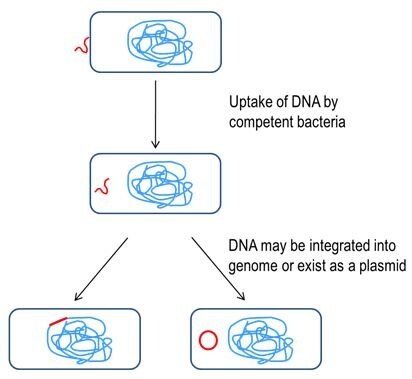Bacterial Transformation
Competent Cells for Transformation
Click here to return to the Molecular Biology Guide.
What is Bacterial Transformation?
Bacterial transformation is a process of horizontal gene transfer by which some bacteria take up foreign genetic material (naked DNA) from the environment. It was first reported in Streptococcus pneumoniae by Griffith in 1928.1 DNA as the transforming principle was demonstrated by Avery et al in 1944.2
The process of gene transfer by transformation does not require a living donor cell but only requires the presence of persistent DNA in the environment. The prerequisite for bacteria to undergo transformation is its ability to take up free, extracellular genetic material. Such bacteria are termed as competent cells.
The factors that regulate natural competence vary between various genera. Once the transforming factor (DNA) enters the cytoplasm, it may be degraded by nucleases if it is different from the bacterial DNA. If the exogenous genetic material is similar to bacterial DNA, it may integrate into the chromosome. Sometimes the exogenous genetic material may co-exist as a plasmid with chromosomal DNA.
Reasons for Transformation
The phenomenon of natural transformation has enabled bacterial populations to overcome great fluctuations in population dynamics and overcome the challenge of maintaining the population numbers during harsh and extreme environmental changes. During such conditions some bacterial genera spontaneously release DNA from the cells into the environment free to be taken up by the competent cells. The competent cells also respond to the changes in the environment and control the level of gene acquisition through natural transformation process.

Figure 1.Schematic representation of transformation in bacteria
Competence of Bacteria
Not all bacteria are capable of taking up exogenous DNA from their environment. The practical approach to acquire competent cells is to make the bacterial cells artificially competent using chemicals or electrical pulses.
- Chemical induction of competence involves the following steps:
- chilling the cells in the presence of calcium phosphate (Catalog Number 50552) to make them permeable
- incubation with DNA
- heat shock treatment at 42 °C for 60-120 seconds that causes the DNA to enter the cells
Note: To endure the heat shock treatment, it is important the cells used are in the log phase of growth
- Alternatively, the bacterial cells are made permeable by subjecting them to electrical pulses, a process known as electroporation.
Sigma-Aldrich offers a wide range of chemically competent cells and electrocompetent cells. Choose the right product for you with our Selection Guide.
What Are Applications of Transformation?
The phenomenon of transformation has been widely used in molecular biology. As they are easily grown in large numbers, transformed bacteria may be used as host cells for the following:
- to make multiple copies of the DNA
- in cloning procedures
- to express large amounts of proteins and enzymes
- in the generation of cDNA libraries
- in DNA linkage studies
What is Required in a Typical Transformation Reaction?
- Competent cells
- Supercoiled plasmid DNA
- Transformation medium
- Selection marker (antibiotic and/or chromogenic substrate)
The materials required and the detailed protocol of transformation can be found here.
Calculation of Transformation Efficiency
The transformation efficiency is defined as the number of transformants generated per µg of supercoiled plasmid DNA used in the transformation reaction.
Transformation efficiency is calculated using the formula below:
Number of Colonies on Plate (df) |
X 1000 ng/µg |
| Amount of DNA plated (ng) |
What Factors Affect Transformation Efficiency?
- DNA used for transformation reaction
- The concentration of DNA must be carefully quantified and the same DNA must be used for all transformations. The pUC19 DNA (Catalog Number D3404) offered by Sigma-Aldrich is accurately quantitated and is suitable to maintain the amount of plasmid DNA used in transformation reactions.
- The transformation reaction is efficient when <10 ng of DNA is used. pUC19 DNA (0.1 ng) is suitable as control.
- Supercoiled DNA is most efficient for transformation compared to linear or ssDNA that has the transformation efficiency of <1%.
- During electroporation, the salts present in the preparation mix may lower transformation efficiency. Limit the volume of plasmid DNA to 1 µL per transformation.
- Column-purified DNA is most suitable as it is devoid of contaminants that interfere with transformation.
- The volume of miniprep DNA must be limited to not more than 5 µL per 50 µL reaction to prevent the contaminants from decreasing the transformation efficiency.
- Ligation mixtures inhibit transformation as the ligases inhibit electroporation of cells. The ligases must be heat-inactivated (65 °C for 5 minutes) before the mixture is added to the cells.
- Heat shock: Optimal heat shock set up is as follows:
- 42 °C for 45 seconds for PCR tubes or thin-walled tubes
- 37 °C for 60 seconds for microfuge tubes or thick-walled tubes
- General set up: 37 °C for 60 seconds
- Time between transformation and plating: The transformation efficiency is significantly decreased as the time between the transformation reaction and the plating is increased. This, however, also depends on the strain and the plasmid used.
- Microbial medium used: SOB medium (Catalog Number H8032) is most suitable for transformation and gives almost two-fold higher transformation efficiency when compared to LB medium (Catalog Numbers L2542, L3522, L3141) for chemically competent cells.
- Selective plates: Commercially prepared agar plates with selection agent (Catalog Numbers L5667, L0168, L0543, L0418, L8795) are most suitable for identifying transformant colonies. Plating large number of cells may give rise to satellite colonies that are not true transformants. Streaking the colonies on selective agar plates is recommended to identify true transformants.
- Freeze/thawing of cells: Activity of cells that are refrozen and thawed is significantly reduced resulting in at least two-fold decrease in transformation efficiency.
Comparison of Transformation and Transfection |
|---|
References
To continue reading please sign in or create an account.
Don't Have An Account?